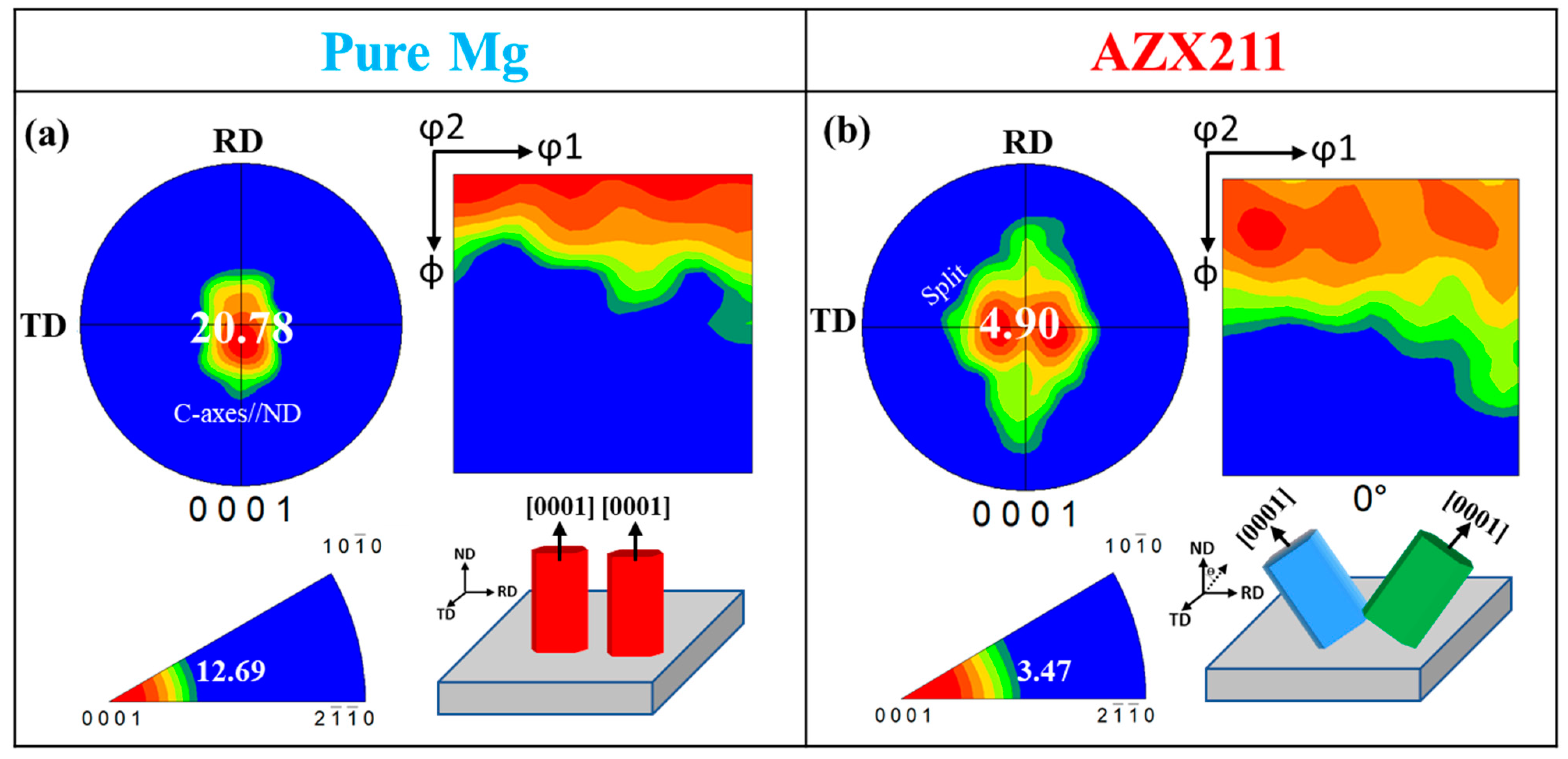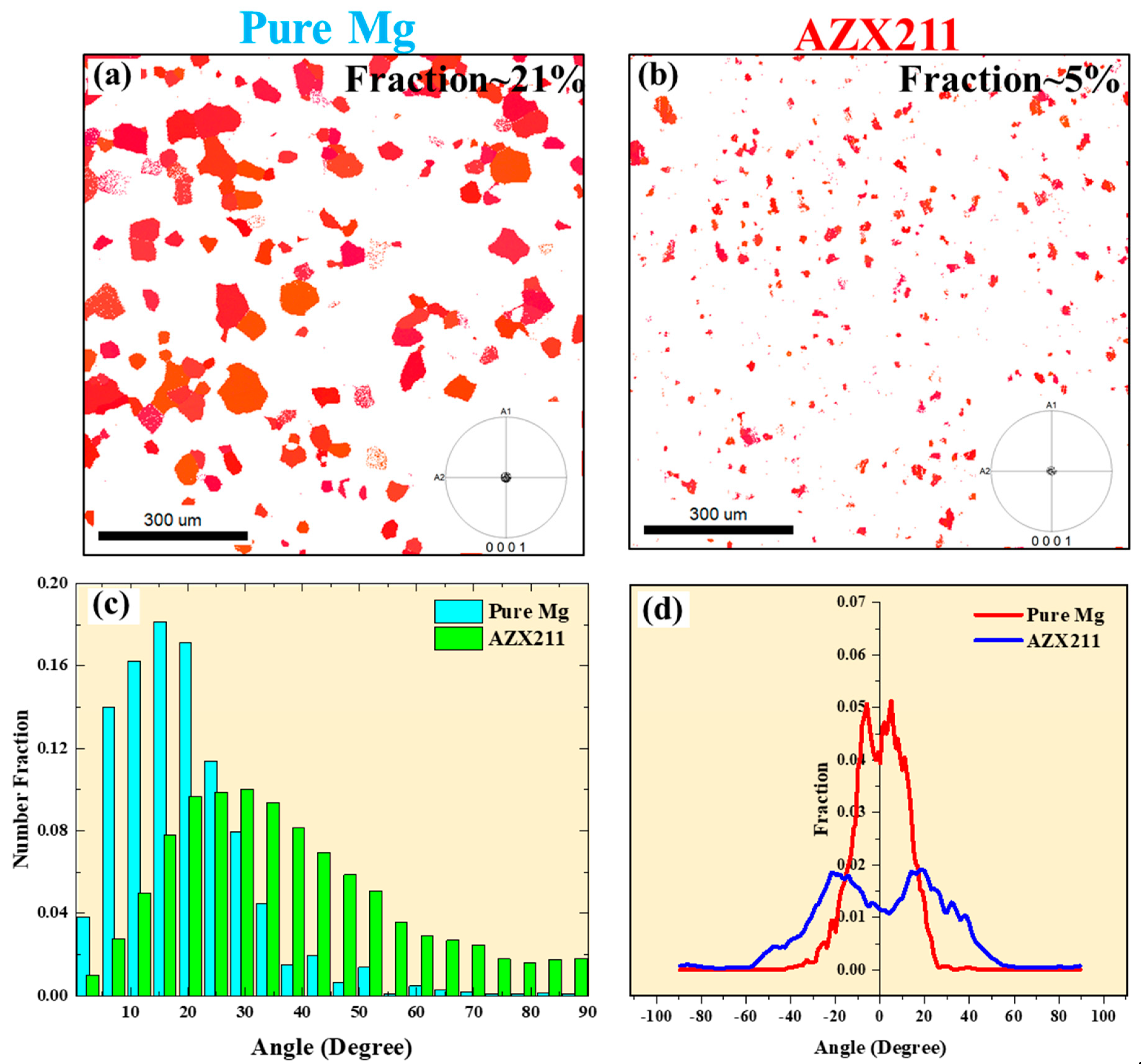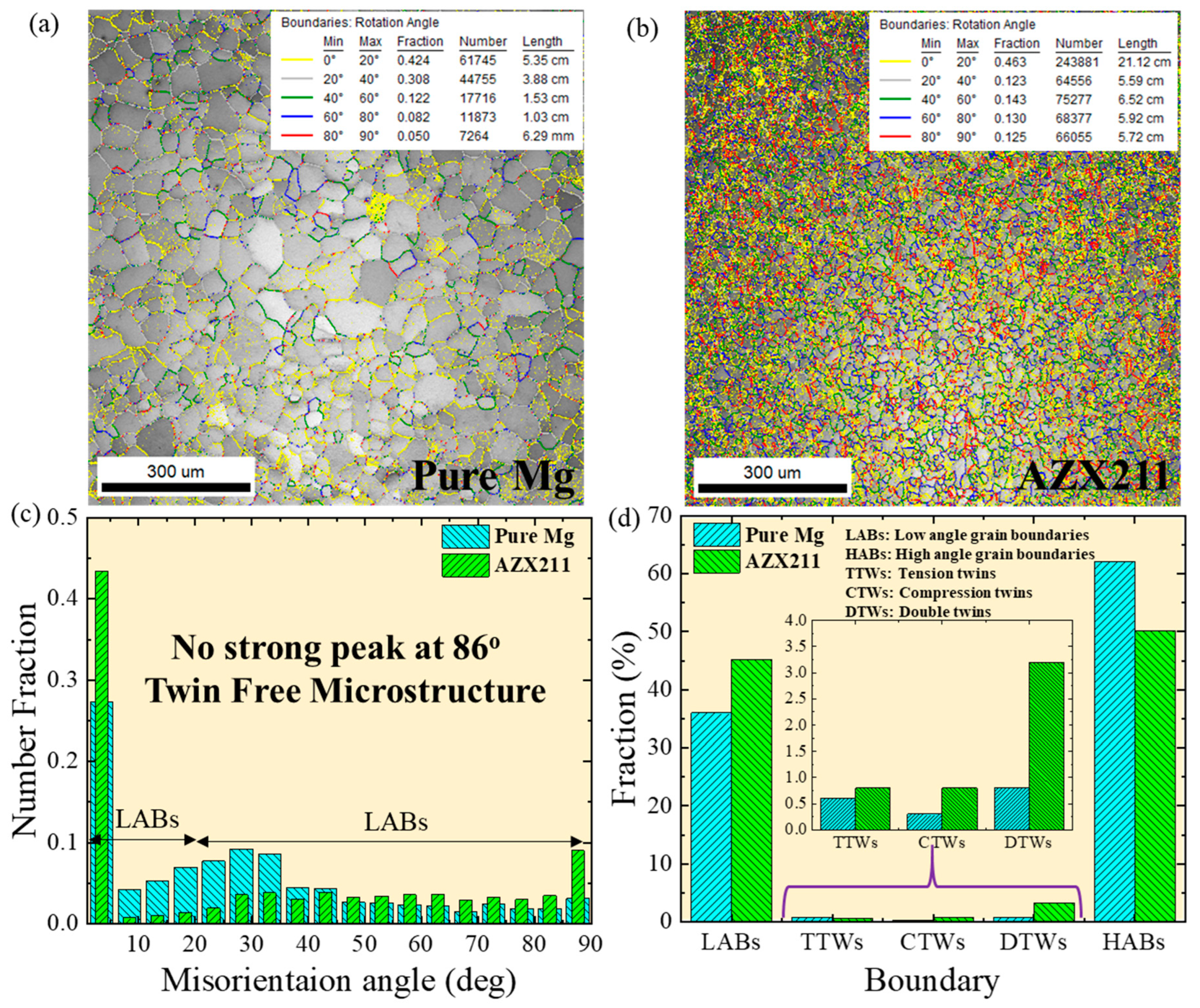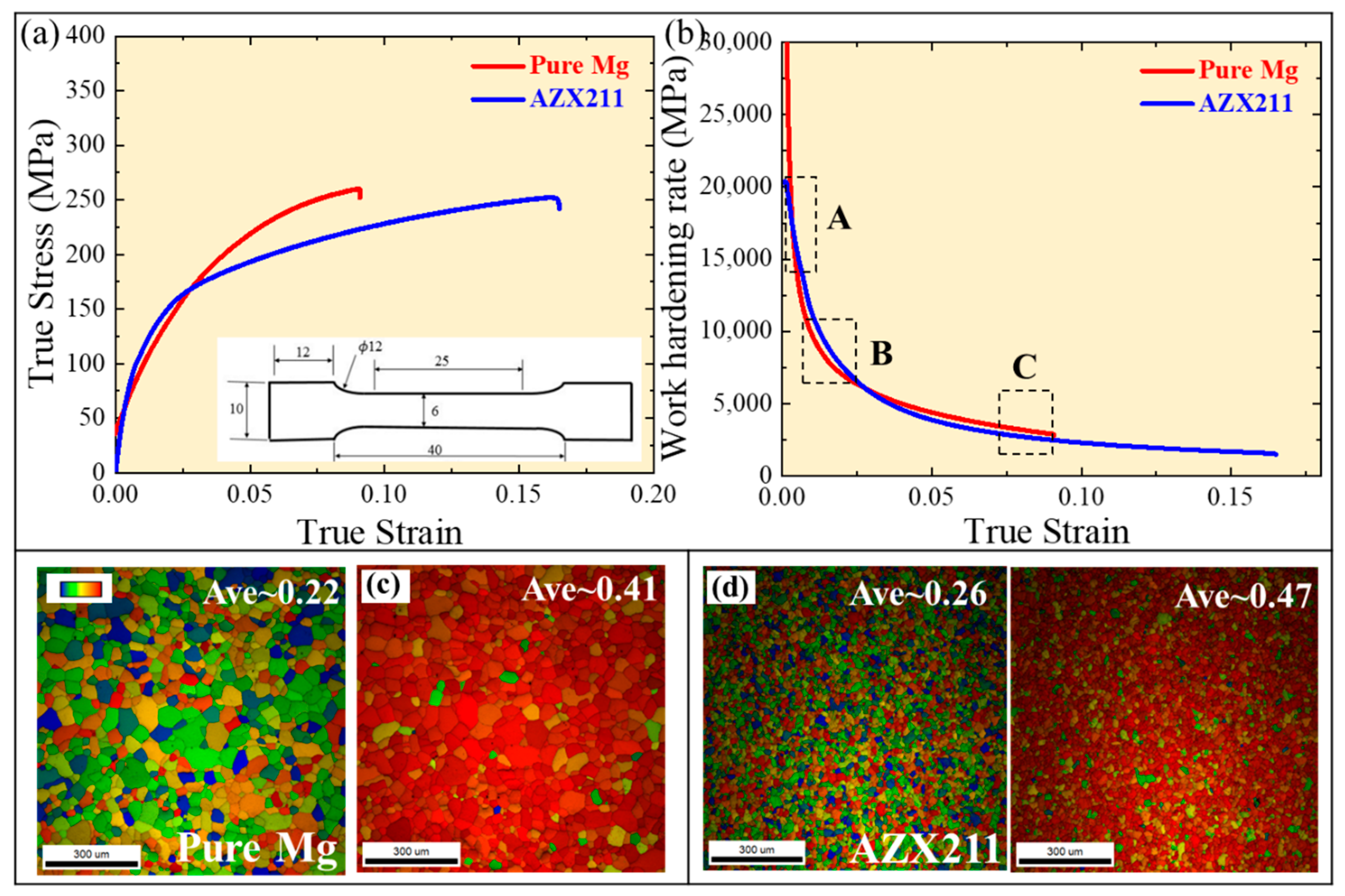Investigating the Microstructure, Crystallographic Texture and Mechanical Behavior of Hot-Rolled Pure Mg and Mg-2Al-1Zn-1Ca Alloy
Abstract
:1. Introduction
2. Experimental
3. Results and Discussion
4. Conclusions
Author Contributions
Funding
Institutional Review Board Statement
Informed Consent Statement
Data Availability Statement
Conflicts of Interest
References
- Hirsch, J.; Al-Samman, T. Superior light metals by texture engineering: Optimized aluminum and magnesium alloys for automotive applications. Acta Mater. 2013, 61, 818–843. [Google Scholar] [CrossRef]
- Masood Chaudry, U.; Tekumalla, S.; Gupta, M.; Jun, T.-S.; Hamad, K. Designing highly ductile magnesium alloys: Current status and future challenges. Crit. Rev. Solid State Mater. Sci. 2021, 47, 194–281. [Google Scholar] [CrossRef]
- Malik, A.; Wang, Y.; Huanwu, C.; Nazeer, F.; Khan, M.A. What is the major problem with wrought Mg alloys? Results Eng. 2020, 7, 100162. [Google Scholar] [CrossRef]
- Chaudry, U.M.; Hamad, K.; Kim, J.-G. On the ductility of magnesium based materials: A mini review. J. Alloys Compd. 2019, 792, 652–664. [Google Scholar] [CrossRef]
- Pan, H.; Ren, Y.; Fu, H.; Zhao, H.; Wang, L.; Meng, X.; Qin, G. Recent developments in rare-earth free wrought magnesium alloys having high strength: A review. J. Alloys Compd. 2016, 663, 321–331. [Google Scholar] [CrossRef]
- Masood Chaudry, U.; Hamad, K.; Kim, J.-G. A further improvement in the room-temperature formability of magnesium alloy sheets by pre-stretching. Materials 2020, 13, 2633. [Google Scholar] [CrossRef]
- Malik, A.; Chaudry, U.M.; Yan, T.; Long, J.; Li, C.; Wang, Y. Achieving higher dynamic mechanical response by adjusting texture through twinning in a ZK61 Mg alloy. J. Alloys Compd. 2022, 902, 163755. [Google Scholar] [CrossRef]
- Malik, A.; Wang, Y.; Nazeer, F. The development of a strong and ductile Mg–Zn–Zr thin sheet through nano precipitates and pre-induced dislocation. Mater. Sci. Eng. A 2021, 817, 141339. [Google Scholar] [CrossRef]
- Lee, S.W.; Han, G.; Jun, T.-S.; Park, S.H. Effects of initial texture on deformation behavior during cold rolling and static recrystallization during subsequent annealing of AZ31 alloy. J. Mater. Sci. Technol. 2021, 66, 139–149. [Google Scholar] [CrossRef]
- Pérez-Prado, M.T.; Ruano, O. Grain refinement of Mg–Al–Zn alloys via accumulative roll bonding. Scr. Mater. 2004, 51, 1093–1097. [Google Scholar] [CrossRef]
- Malik, A.; Masood Chaudry, U.; Hamad, K.; Jun, T.-S. Microstructure Features and Superplasticity of Extruded, Rolled and SPD-Processed Magnesium Alloys: A Short Review. Metals 2021, 11, 1766. [Google Scholar] [CrossRef]
- Malik, A.; Wang, Y.; Cheng, H.; Nazeer, F.; Khan, M.A. Microstructure evolution of Mg-Zn-Zr magnesium alloy against soft steel core projectile. J. Mater. Sci. Technol. 2021, 79, 46–61. [Google Scholar] [CrossRef]
- Masood Chaudry, U.; Hamad, K.; Kim, J.-G. Optimisation of structure for enhancing the room-temperature stretch formability of magnesium alloy. Philos. Mag. Lett. 2020, 100, 461–467. [Google Scholar] [CrossRef]
- Masood Chaudry, U.; Hamad, K.; Kim, J.-G. Ca-induced plasticity in magnesium alloy: EBSD measurements and VPSC calculations. Crystals 2020, 10, 67. [Google Scholar] [CrossRef]
- Valiev, R.Z.; Langdon, T.G. Principles of equal-channel angular pressing as a processing tool for grain refinement. Prog. Mater. Sci. 2006, 51, 881–981. [Google Scholar] [CrossRef]
- Malik, A.; Wang, Y.; Nazeer, F.; Khan, M.A.; Ali, T. Effect of pre-straining on twinning, texture and mechanical behavior of magnesium alloys A-review. J. Mater. Res. Technol. 2020, 9, 14478–14499. [Google Scholar] [CrossRef]
- Bourezg, Y.I.; Azzeddine, H.; Baudin, T.; Helbert, A.-L.; Huang, Y.; Bradai, D.; Langdon, T.G. Texture and microhardness of Mg-Rare Earth (Nd and Ce) alloys processed by high-pressure torsion. Mater. Sci. Eng. A 2018, 724, 477–485. [Google Scholar] [CrossRef]
- Griffiths, D. Explaining texture weakening and improved formability in magnesium rare earth alloys. Mater. Sci. Technol. 2015, 31, 10–24. [Google Scholar] [CrossRef]
- Masood Chaudry, U.; Hoo Kim, T.; Duck Park, S.; Sik Kim, Y.; Hamad, K.; Kim, J.-G. On the high formability of AZ31-0.5 Ca magnesium alloy. Materials 2018, 11, 2201. [Google Scholar] [CrossRef]
- Chaudry, U.M.; Noh, Y.; Han, G.; Jaafreh, R.; Jun, T.-S.; Hamad, K. Effect of CaO on structure and properties of AZ61 magnesium alloy. Mater. Sci. Eng. A 2022, 844, 143189. [Google Scholar] [CrossRef]
- Chaudry, U.M.; Hamad, K. Effect of calcium on the superplastic behavior of AZ31 magnesium alloy. Mater. Sci. Eng. A 2021, 815, 140874. [Google Scholar] [CrossRef]
- Han, G.; Noh, Y.; Chaudry, U.M.; Park, S.H.; Hamad, K.; Jun, T.-S. {10–12} extension twinning activity and compression behavior of pure Mg and Mg-0.5 Ca alloy at cryogenic temperature. Mater. Sci. Eng. A 2022, 831, 142189. [Google Scholar] [CrossRef]
- Liu, X.; Qiao, X.; Xie, W.; Pei, R.; Yuan, L.; Zheng, M. Influence of grain size on microstructure, mechanical properties and strain hardening behavior of Mg-0.3 Ca (wt.%) alloy. Mater. Sci. Eng. A 2022, 839, 142847. [Google Scholar] [CrossRef]
- Chaudry, U.; Kim, Y.; Hamad, K. Effect of Ca addition on the room-temperature formability of AZ31 magnesium alloy. Mater. Lett. 2019, 238, 305–308. [Google Scholar] [CrossRef]
- Pei, R.; Korte-Kerzel, S.; Al-Samman, T. Superior microstructure and mechanical properties of a next-generation AZX310 magnesium sheet alloy. Mater. Sci. Eng. A 2019, 763, 138112. [Google Scholar] [CrossRef]
- Chaudry, U.M.; Kim, T.H.; Kim, Y.S.; Hamad, K.; Ko, Y.G.; Kim, J.-G. Dynamic recrystallization behavior of AZ31-0.5 Ca magnesium alloy during warm rolling. Mater. Sci. Eng. A 2019, 762, 138085. [Google Scholar] [CrossRef]
- Chaudry, U.M.; Farooq, A.; bin Tayyab, K.; Malik, A.; Kamran, M.; Kim, J.-G.; Li, C.; Hamad, K.; Jun, T.S. Corrosion behavior of AZ31 magnesium alloy with calcium addition. Corros. Sci. 2022, 199, 110205. [Google Scholar] [CrossRef]
- Pei, R.; Zou, Y.; Zubair, M.; Wei, D.; Al-Samman, T. Synergistic effect of Y and Ca addition on the texture modification in AZ31B magnesium alloy. Acta Mater. 2022, 233, 117990. [Google Scholar] [CrossRef]
- Yi, S.; Bohlen, J.; Heinemann, F.; Letzig, D. Mechanical anisotropy and deep drawing behaviour of AZ31 and ZE10 magnesium alloy sheets. Acta Mater. 2010, 58, 592–605. [Google Scholar] [CrossRef]
- Zeng, Z.; Zhu, Y.; Xu, S.; Bian, M.; Davies, C.; Birbilis, N.; Nie, J.F. Texture evolution during static recrystallization of cold-rolled magnesium alloys. Acta Mater. 2016, 105, 479–494. [Google Scholar] [CrossRef]
- Lee, T.; Robertson, I.; Birnbaum, H. AnIn Situ transmission electron microscope deformation study of the slip transfer mechanisms in metals. Metall. Trans. A 1990, 21, 2437–2447. [Google Scholar] [CrossRef]
- Kacher, J.; Minor, A.M. Twin boundary interactions with grain boundaries investigated in pure rhenium. Acta Mater. 2014, 81, 1–8. [Google Scholar] [CrossRef]
- Zhao, J.; Jiang, B.; Xu, J.; He, W.; Huang, G.; Pan, F. The influence of Gd on the recrystallisation, texture and mechanical properties of Mg alloy. Mater. Sci. Eng. A 2022, 839, 142867. [Google Scholar] [CrossRef]







| Elements | Concentration | wt.% | Atomic.% |
|---|---|---|---|
| Mg | 28.12 | 47.22 | 53.02 |
| Al | 10.93 | 33.37 | 33.76 |
| Ca | 8.83 | 19.41 | 13.22 |
Publisher’s Note: MDPI stays neutral with regard to jurisdictional claims in published maps and institutional affiliations. |
© 2022 by the authors. Licensee MDPI, Basel, Switzerland. This article is an open access article distributed under the terms and conditions of the Creative Commons Attribution (CC BY) license (https://creativecommons.org/licenses/by/4.0/).
Share and Cite
Chaudry, U.M.; Hamad, K.; Jun, T.-S. Investigating the Microstructure, Crystallographic Texture and Mechanical Behavior of Hot-Rolled Pure Mg and Mg-2Al-1Zn-1Ca Alloy. Crystals 2022, 12, 1330. https://doi.org/10.3390/cryst12101330
Chaudry UM, Hamad K, Jun T-S. Investigating the Microstructure, Crystallographic Texture and Mechanical Behavior of Hot-Rolled Pure Mg and Mg-2Al-1Zn-1Ca Alloy. Crystals. 2022; 12(10):1330. https://doi.org/10.3390/cryst12101330
Chicago/Turabian StyleChaudry, Umer Masood, Kotiba Hamad, and Tea-Sung Jun. 2022. "Investigating the Microstructure, Crystallographic Texture and Mechanical Behavior of Hot-Rolled Pure Mg and Mg-2Al-1Zn-1Ca Alloy" Crystals 12, no. 10: 1330. https://doi.org/10.3390/cryst12101330






